In This Issue
-
Jacki Apple ● Leslie Labowitz: Sprout Actions
-
Evgenia Emets ● Eternal Forest
-
Robyn Woolston ● Notes From The Precipice
-
Edie Dillon ● Art & Healing On
Sacred Land -
Zea Morvitz ● Mary Eubank
Artist, Community Nonprofit Gallerist -
Lauren Elder ● Disappearing Hardwoods
-
Mierle Laderman Ukeles ● Touch Sanitation
-
Mary Jo Aagerstoun ● Eco Art and Black Americans’ Relationships to the Land
-
Teresa Camozzi ● Climate Change Dressed In A Fire Gown
-
Ria Vanden Eynde ● Feminist Activist Painting
-
Susan Leibovitz Steinman ● Taking Action
LAUAN: DISAPPEARING TROPICAL HARDWOODS
I. DISAPPEARING TROPICAL HARDWOODS
LAUAN, LUAN, LAWAAN, Meranti, Seraya, Balau, Bangkirai, and Philippine mahogany.
All are trade names for the plywood produced from massive tropical hardwood trees harvested legally or illegally from the rainforests of South and Southeast Asia. Their range stretches from Northern India through Indonesia (including Borneo), Malaysia and the Philippines. The wood is used in a vast array of products including furniture and cabinetry (interiors, backs and bottoms), architectural millwork, sub-flooring, wall paneling, door skins, crafts, and movie/theatre set construction.
The list of names sounds like an incantation and in some way it is, as the rape of the rainforests has driven these ecosystems to the point of exhaustion. One would do well to pray.

CURLED LUAN PLYWOOD.
‘Money is killing the world’ says Babulu, a former Penan headman from Borneo, locus of the most drastic deforestation. Not only does the clear-cutting rob us of the trees and their vital functions: clean air, clean water, regulated temperatures. ‘It also banishes the spirits who accompany the trees and blinds us to the perception of the 9 layers of our precious existence.’ (1)
I began this research because, as a former scenic design artist, I had a close connection with the material. Just like my colleagues, I happily – and ignorantly – consumed large quantities of this gorgeous plywood. Strong, flexible, light, a joy to cut and paint, it enabled us to create worlds of any description. Although I stopped depending on lauan two decades ago, I decided to track the path of tropical timber extraction into the present. The route has been twisted and thorny and has left me in a state of profound grief, not just for the trees but for the uncounted species of flora and fauna who have disappeared along with them – some before they could even be recognized and named. (2) This story has been told already from many viewpoints, but I am excited to be knitting the various strands into a whole, blending my personal conversion into the picture. The situation is grim but not entirely hopeless. Using our creativity, we can make changes in design and choose alternate materials, processes and standards. One of our strongest tools is the direct influence we have over our own communities of suppliers, peers, clients and students by educating each other and collectively reimagining methodologies. Resistance to the norm is our only viable way forward. I will be offering concrete suggestions later in this article.
But now, I invite you to take the journey beginning in a pristine area of the rainforest in Borneo, one of the oldest in the world, one that formed between 130-140 million years ago. By comparison, the oldest segments of our Grand Canyon are calculated to be around 70 million years old.
Imagine yourself bathing in the emerald light of a dense jungle, among swaying tropical hardwood trees towering 35 meters or more into the clouds.
Imagine the soft wet breath of the air on your neck and lose yourself to the animal conversations ricocheting throughout the space. Birds, insects, monkeys, apes, large cats and more: screeching, buzzing, squawking, chattering, whooping, trilling from the dark moist soil to the tree tops in an orchestrated series of call and response.
If your imagination wants a boost, open this audio file and enjoy as you read on:
Recorded by George Vlad, the sounds you are hearing drop us into the rainforest of Borneo which is renowned for being the hotspot of Shorea diversity. Shorea is a genus of tropical rainforest trees comprising 138 species, of which 91 are endemic to the island. Shorea is the largest genus belonging to the larger family of Dipterocarpaceae (from the Greek, di = two, pteron = wing and karpos = fruit). (3)
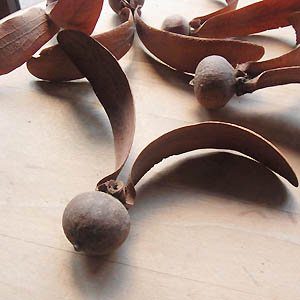
SHOREA SEEDS, Jam Kobayashi website.
You are in the midst of the richest biological zone on our planet. For example: Dipterocarp trees hold the greatest insect diversity on Borneo – as many as 1,000 species can be found in just 1 tree! (4)
(For a detour through some of the insect inventory click here.)
Of the 148 species of Shorea currently appearing on the IUCN Redlist, 11 are listed as being Critically Endangered. This should be no surprise since many species are economically valuable timber trees that have been ruthlessly clear-cut since the 1980’s to feed a global hunger for cheap construction materials. And Lauan was astonishingly cheap! Far less than a comparably sized sheet of fine art paper.
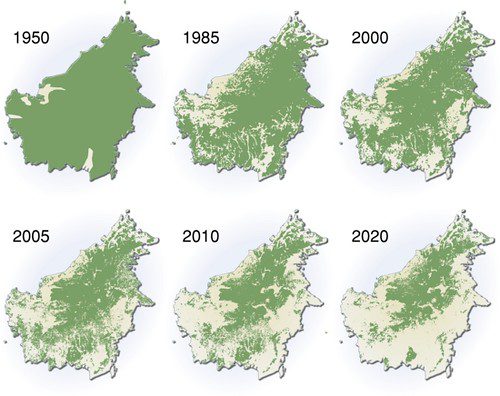
JUNGLE SHRINKS. BORNEO. Cartographer: Hugo Ahlenius
When my Father returned from Borneo after WWII, he described the landscape as ‘impenetrable’. According to the Smithsonian, at least 30 percent of Borneo’s tropical forest have been destroyed over the last 40 years. The global loss of rainforests is one of the gravest problems we face as it is bound up with both climate change and species extinction simultaneously. Who knows what extraordinary wild medicines and foods may have been lost? (5)
Both the problem and its solution are the same: It’s the money. We are coming to that.
II. ‘FESSING UP
AS I NOTED, I BEGIN WITH a ‘confession’: As a scenic designer, I chewed through stacks of this beautiful wood in order to build sets – without much consideration of the implications. Where did it come from? The lumber yard. Where was it going after the show? If it couldn’t be refashioned into another set, it might be chipped at the dump and perhaps become mulch. This scene is from my 1992 production ‘Surrender’ at Theater Artaud.
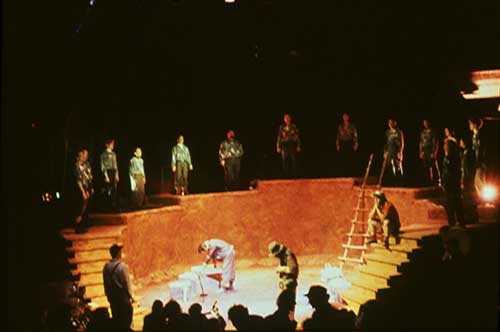
SURRENDER ,Theater Artaud, San Francisco, CA (1992-3). Photo: Lauren Elder
All that changed around 2000. After 25 years, I emerged from the ‘black box’ of the theater space and its ‘other reality’ into the light of the natural world. I started asking those ‘inconvenient questions’ about my materials. Who harvested it? Under what conditions? Were they paid fairly? Were the working conditions safe? Did they cut selectively or just bulldoze endless acres? What replaced the cut trees? Where did the animals go? What could we use as an alternative material? I discovered that I was a decade or so ‘behind the curve’ in this process of questioning!
III. A SHORT HISTORY OF LENGTHY RESISTANCE
TIM KEATING WILL BE OUR guide for this portion of the trek. As the founder of Rainforest Relief and the parallel wood consultancy, earthbilt.com, he shares both history and insights based on three decades of rainforest activism.
The story of harvesting tropical hardwoods for lauan began in the Philippines as early as the 1930’s. New milling techniques, known as rotary cutting, introduced by the Japanese, produced a boom in extraction by the 1950’s. The logs were perfect for creating this plywood product because they were straight, with stable wood fibers, consistent in color and easy to peel to make the veneers. Inevitably, as demand increased, the pressures on the supply of hardwoods also grew until the Philippine jungles were 80% exhausted by the late 1980’s.The clearing was so severe that drought and then erosion prompted a logging moratorium in 1989 but this did not end illegal harvesting which continues to this day.
Logging then moved on to Malaysia by the mid-80’s and extended into Indonesia, particularly Borneo, as described above. By the 1990s, plywood manufacturers had widened their source materials to include hardwoods from other regions around the globe such as Africa, South America and the South Pacific. Because most of these source plantations were not sustainably harvested, the supply continued to dwindle, i.e. tropical rainforests were being destroyed at a breath-taking rate.
Lauan plywood was used widely, not just in scenery for theater and film. It appeared in cabinetry, furniture, flooring, concrete forms, interior veneers, musical instruments and more.
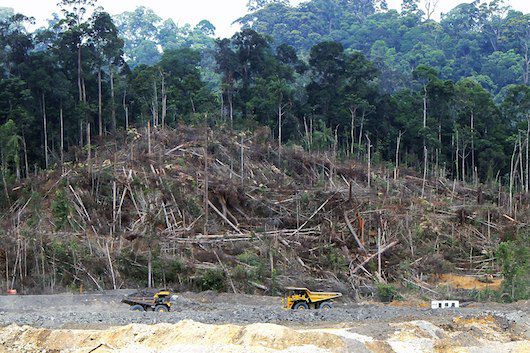
CLEAR CUTTING. Credit: Wikimedia Commons
By the late 1980’s, US activists and their foreign counterparts began to organize direct grassroots actions against offending timber companies and the importers and distributors of illegally harvested tropical hardwoods. These actions included covert surveillance of shipping activities, dockers’ strikes to refuse unloading cargo, protests within the stores of vendors as well as meetings with any members of the press who would listen and respond. By the early 1990’s Home Depot controlled 10% of the US retail lumber trade, and so actions against them were critical. Rainforest Action Network launched a Tropical Timber Campaign against their sales of lauan that put the company on notice. RAN’s work continued until the mid-90’s when the focus shifted to the harvesting of Sitka Spruce and Western Red Cedar from British Colombia, but Tim Keating and his NY-based Rainforest Relief continued to speak out on behalf of tropical hardwoods including lauan. Home Depot reportedly capitulated to activist pressure by 1999 and released their first wood purchasing guidelines to avoid products from endangered forests. (6)
On the West Coast, EMA (Environmental Media Association) has worked energetically, partnering with celebrities, to put pressure on the entertainment industry to adopt green practices that are good for business as well as the planet. Their ‘Green Carpet” Awards attracted wide attention, featuring alternatives to wasteful practices.
The early direct action campaigns have shifted as the organizations have matured. Direct action has been supplanted by pressure tactics on financial investors and corporations with large banks being a particular target. In the current decade(s) protests have shifted away from logging per se and towards the mass mono-cropping of palm oil trees. Logging concessions are masked as acceptable permits to clear and convert land for agriculture, i.e. palm oil plantations.
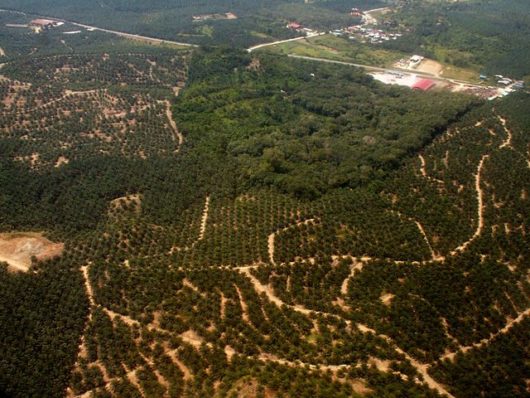
AERIAL VIEW OF A RAINFOREST fragment amidst large expanse of oil palm plantations in Sabah, Malaysian Borneo. TR Shankar Rama (Wikimedia Commons)
Whether you call it logging or farming, the net result is the same: a massive giveaway of the jungles of Southeast Asia.
IV. RECENT PROTESTS
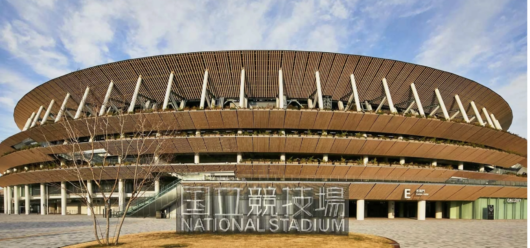
JAPANESE NATIONAL STADIUM. Photo: Tokyo 2020
OUR COLLECTIVE ‘VOICE OF CONSCIENCE’ has grown louder and reached further over the decades since the 90’s, but not loud enough to halt the ongoing pillage. Just recently the Japanese Olympic Organizing Committee has confirmed that 87% of the plywood panels used to build its new national stadium come from Southeast Asian rainforests after a prior pledge that projects would not be ‘illegal, unsustainable or linked to human rights violations’. Complaints were filed by Rainforest Action Network ‘insisting that they investigate supply chain impacts, and engage in a constructive dialogue about how to do better going forward.’ (7)
Well the damage is done. And approximately 50% of Japanese citizens did not even want the games to continue!
V. THE MOVIE INDUSTRY

MOVIE SET UNDER CONSTRUCTION. CREDIT: Studio Babelsberg
‘Ceci N’est Pas Le Guggenheim’
Is this the Guggenheim during an Installation? or Is this the Guggenheim as an installation? It’s wonderfully convincing, isn’t it?
The historic and renowned Studio Babelsberg fabricated this museum replica for the 2007 film, The International, proving once more that art and life are busy chasing each others’ tails, and meanwhile the rainforests are the real losers. A review of their website did not reveal a statement on sustainable practices so it’s hard to know if they used an alternative for lauan which is perfect for a design like this. It’s wonderfully light, strong, flexible – and as mentioned, cheap!
This one set was presumably demolished at the conclusion of the shoot. Now, do the math: According to IMDB, since 1900 there’s been an average of 2,577 films produced each year around the world.
As measure of wasteful use: ‘The region’s entertainment industry (Hollywood) consumes about 250,000 sheets of lauan plywood each year, according to surveys conducted by environmental consultant David Kupfer (8). While Hollywood, under pressure, may have moved towards more eco-friendly practices, there are vast film production companies in India (Bollywood), China, Nigeria (Nollywood) and Egypt. Statistics on lauan use for these industries are not easy to find.
VI. AND WHAT ABOUT CHINA?
SIXTH TONE, AN INVESTIGATIVE GROUP inside China, offered this report: ‘As the world’s manufacturing hub, China is the biggest importer and consumer of wood products. Over 60% of tropical logs on the global market are imported to China. ‘Much tropical wood comes from species which environmentalists consider at high risk for being logged illegally. Assessments by the United Nations Environment Program and Interpol suggest that 15 to 30 percent of timber traded globally has been illegally harvested — in tropical countries, this proportion could be as high as 50 to 90 percent. Illicit timber trade is one of the most profitable forms of environmental crime.’ (9).
This brings us to yet another dilemma .
VII. CERTIFICATION
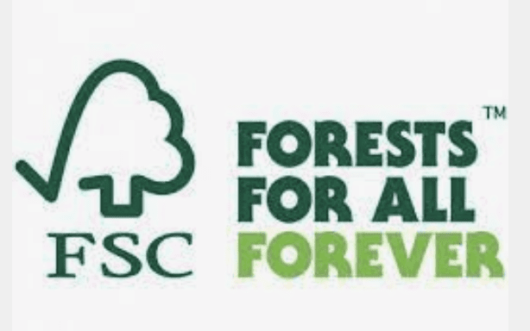
LOGO FOR FSC
THE PROBLEM OF RELIABLE certification continues to plague the sustainable/green logging industry to this day. It used to be sufficient for manufacturers, merchants, and fabricators to point to the label on the box and claim sustainability. The problem is that the practice is voluntary, i.e. there is no enforcement mechanism.
Greenpeace very recently charged:
Certification on its own has not helped companies meet their 2020 commitments to exclude deforestation from their supply chains. Certification schemes often fall short in how their standards are interpreted, implemented and enforced. The case studies in the report show how the RTRS, ProTerra, FSC and RSPO have all certified companies that have been accused of breaching standards and/or having links to environmental destruction and/or human rights abuses. And when certificate holders or CBs breach certification standards, the consequences are not necessarily swift or severe. (10)
VIII. 2021 AND THE FUTURE
SO WHERE ARE WE NOW? Vast tracts of rainforest clear cut for timber and/or the planting of palm oil plantations. The air choked with smoke by the fires set to complete the clearing. Disrupted peat deposits smoldering and releasing vast amounts of C02 into the atmosphere. Millions of rainforest-dwellling species banished overnight from their homes. Indigenous peoples unseated from their lands. And the orangutan, poster child for the movement to stop these practices, is now on the Critically Endangered list. It’s a dire scenario seen from any angle. Either we fall into despair or ‘we pull up our socks’ and continue to be proactive.

SUMATRAN ORANGUTAN MOTHER AND BABY. Photo: Wikimedia Common
And who could resist defending our curious and intelligent cousins? It’s estimated that 2000-3000 Orangutans perish each year. As their jungle homes are destroyed by deforestation, they come into greater contact and conflict with humans who may capture, injure or kill them for bush meat, the illegal pet trade or simply because both people and apes compete for food supplies (11).
So what are the alternatives?
RESEARCH. RESIST. RENEW. REIMAGINE
IX. RESEARCH
– Track the certification of your plywood veneer as best as possible to find out if it is indeed accurate. It’s a tricky business as noted. LeNoble Lumber (New York Area) advertises the sale of FSC certified luan.
– Investigate ways to purchase a sustainably grown wood alternative.
Patriot Timber claims to be a reliable source at present. EarthBilt based in New Jersey, also offers alternatives. See RENEW below.
– Talk with your colleagues. What do they consider best practices? Do they need some education? Or are they already aware? Can you offer tips such as the following:
On April 15, 2021 FSC US officially launched OneSimpleAction.org, making it easier than ever for consumers to find and buy more responsibly sourced forest-based products. But .bear in mind the GreenPeace challenge.
– We have been discussing timber, but the current leading contender for deforestation is palm oil! Read the labels on food products. ‘Conflict Palm Oil is found in roughly half of all packaged products sold in U.S. grocery stores. It is now the most widely used vegetable oil on Earth. As ‘Palm Oil’ or as a hidden ingredient, it’s in everything from snack foods like chips and ice cream to candy and instant noodles. It’s even found in household items like soaps and lotions, toothpaste and shampoo.’ (12)
We now have to carry a magnifying glass to read labels while shopping!
X. RESIST
– Participate in a campaign to boycott merchants who continue to sell non-certified tropical hardwoods. I telephoned three major lumber yards locally and none of them had certified luan for sale. ‘It’s really hard to get!’ one of the salesmen lamented.
– Join or support the work of an activist organization working to save the rainforests. There are two based in the Bay Area: Amazon Watch (www.amazonwatch.org) and Rainforest Action Network. (www.ran.org). Artists can make a special contribution by creating banners, picket signs, posters, props and more. Visuals at demonstrations are always effective.
– Follow the money trail: Colgate-Palmolive, Ferrero, Kao, Mars, MondelÄ“z, Nestlé, Nissin Foods, PepsiCo, Procter & Gamble, Unilever, ABN Amro (Netherlands), Bank Negara Indonesia, CIMB, DBS (Singapore), ICBC (China), JPMorgan Chase and Mitsubishi UFJ are some of the worst offenders in terms of supporting wholesale rainforest destruction. Switch your investments to a non-offending bank and stop supporting these corporations. (13)
– Demand that the US government and US companies withdraw support of corrupt regimes engaged in illegal logging.

Mel Gibson & Linda Hunt,The Year of Living Dangerously, 1985. Photo: IMDB
As an older, but still significant example: The CIA was heavily involved in the ouster of Indonesian President Sukarno during a shockingly bloody period from 1965 -1967. Suharto, the pro-Western military general who opposed him, took control as the President of an autocratic and corrupt regime from 1967-1998 during which time he issued immensely lucrative contracts to family members and cronies, ushering in the worst excesses of tree clearcutting throughout their country. In the 1985 film, The Year of Living Dangerously, a young Mel Gibson plays a daring journalist who literally supports Linda Hunt aka Billy Kwan as s/he documents the civil unrest of the transition.
XI. RENEW
– Support programs that assist Indigenous communities in controlling their lands and creating and managing businesses that provide direct income from sustainable harvesting of wild fruits and wild medicines. Indigenous peoples who live in the rainforest are the frontline of defense.
– Support the work of Orangutan Foundation International, based in Borneo. Their extraordinary programs include rehabilitation and release of injured and orphaned apes, ecological education of local residents, land purchases to protect habitat from extraction industries, and reforestation of logged and burned lands.
– Support businesses committed to ‘doing good’ for the rainforests. Alter Eco chocolates offers grants to assist farmers in cultivating cacao in diversified plantation schemes.
– Support reforestation programs at home and abroad. Do you have an organization like Tree People in your area? Can you donate a weekend planting trees?
XII. REIMAGINE
– Do you have connections within film, theater, architecture, construction or interior design? Can you offer these individuals the opportunity to reevaluate their production methods? For example: Safe Sets is a technical sheet that offers advice on alternative products.
– Do you want to specify an alternative to tropical hardwoods? EarthBilt is a New Jersey-based company that specializes in recommending and distributing various sustainable timber alternatives to tropical hardwoods. After 26 years of activism, they now practice what they preached as www.rainforestrelief.org. Their parallel website is https://slowwood.info
– Teach your art and design students to evaluate their materials. Make sustainability an integral part of their learning and production.
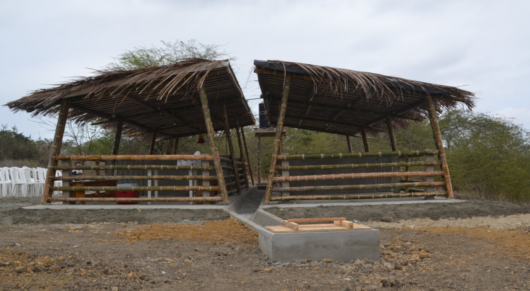
HOG BARN made from Bamboo, Puerto El Moro, Ecuador, 2014. Photo: Lauren Elder
This graceful structure was designed and realized by my CCA students in collaboration with the farming co-op Tierra Fertil through a Social Impact grant. Bamboo is ubiquitous and 100% sustainable in this region. More information is available at www.laurenelder.com
– Support the work of eco-organizations especially where you can be directly engaged in the work.

RESTORING MANGROVES. Photo: www.ecoviva.org
– Don Chema, the ecologist, is overseeing the mangrove forest restoration program run by Asociación Mangle near the Bay of Jiquilisco in coastal El Salvador. I was invited to paint murals with their community members in order to honor their citizen-based environmental work. Mangle’s planning considers the entire watershed: from reforestation with native trees on the mountain slopes, down to diversified agriculture in the lowlands and mangrove restoration on the Pacific coast. And, they offer training and create employment for local residents in the process. (14)
– Enjoy and support the use of media resources. Programs like David Attenborough’s One Planet offer breath-taking nature photography and reliable environmental education to millions of viewers who can explore the rainforest without leaving a carbon footprint! This image from the series steals a look at a Bornean Bat snoozing inside a jungle pitcher plant. The bat receives shelter and in exchange offers the plant his nourishing feces. Uncounted intricate relationships, evolved over millennia, could be lost forever
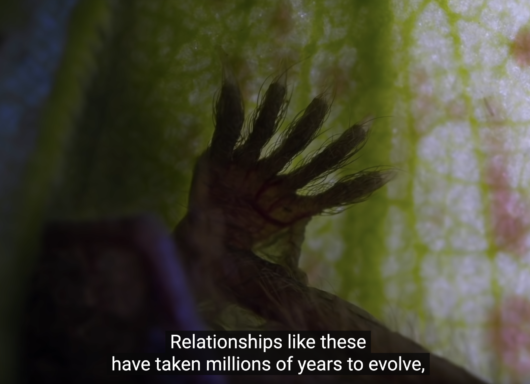
Still from the One Planet Series: Jungles.
XIII. RECENT ACTIVITY
AS WE NEAR THE END end of this journey, I offer an image of the way I make stage sets now. It’s so much more enjoyable and so much better for everyone! This kinetic piece was created for Randee Paufve’s dance production, XO (2017). An assembly of flowering tree branches gently rotates around a central column of feathers. It was made entirely from recycled materials, most sourced locally, and was virtually free. Our arborist, Kingman Lim, and his tree trimming crew have become a major source of materials for art projects. They deliver everything from twiggy bits to entire limbs to sections of trunks. The cut materials experience ‘one more life as a tree’ before being turned into mulch for the garden. The process is satisfying in its economy and mutual benefit.

KINETIC TREE SCULPTURE, Randee Paufve’s dance production XO, San Francisco, CA 2017. Artwork and photo by Lauren Elder.
For architectural scale design, I am still wedded to bamboo which I first encountered while working in Colombia. Bamboo is not just a tropical ‘exotic’. There are many species that flourish in our temperate climate. What I can’t harvest from local gardens, I can purchase from suppliers and not feel overly concerned about sustainability issues. I would suggest sourcing the larger diameter cane (Guadua angustifolia) from South America. And looking beyond cane bamboo, there are now many types of flat goods, made by laminating split cane, that lend themselves to geometric construction. I am looking forward to more public projects that can promote the use of this amazingly versatile material. As designers and artists we can create work that transcends the stereotype of ‘The Tiki Room’ and promotes greater sustainability in the selection of material.
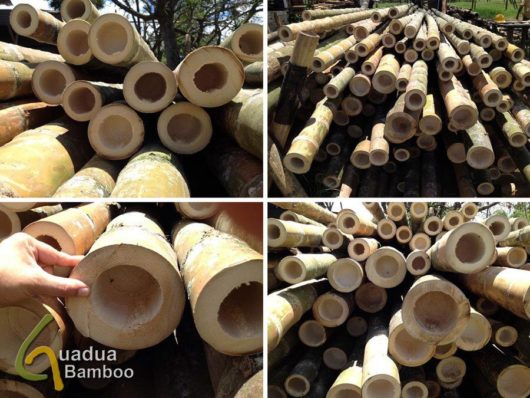
GUADUA BAMBOO POLES. Credit: Guadua Bamboo.
And a final reflection This is the end of our trail for now . a magic circle in a grove of coastal redwoods (Sequoia sempervirens).They are sky-scraping trees, the world’s record holders at 350 feet, just ahead of the tallest Shorea faguetiana at 305 feet. Like the Dipterocarps, they were ruthlessly clear-cut, starting in the days of the California Gold Rush, until only 5% of old growth forest remains, protected by parks and lands held in conservancy.

REDWOOD GROVE. Photo Tree Hugger.
It has taken decades to preserve them as well as the 2nd and 3rd growth forests. Unwavering campaigns have educated the public about the necessity of responsible forestry and supported the strategy of consumer pressure on both business and government. Resistance works. And so does creative action. It strengthens my resolve to support the parallel campaigns for tropical forests that are half a world away but sharing our one planetary breath.
FOOTNOTES
- Quote. ‘In Borneo’s Ruined Forests, Nomads Have Nowhere to Go’, Alex Shoumatoff; Photographs by Varial , Smithsonian Magazine, March 2016.
- Ibid.
- Photo: Seed pod of Dipterocarpus obtusifolius
- World Wildlife Fund
- Cartographer: Hugo Ahlenius
- https://www.wsj.com/articles/SB96993154428491509
- https://www.climatechangenews.com/2018/02/23/tokyo-olympics-confirms-use rainforest-timber-stadium-build/
- https://www.latimes.com/archives/la-xpm-1993-02-11-we-1427-story.html
- https://www.sixthtone.com/news/1003369/how-illegally-harvested-timber-is greenwashed-in-china (2019)
- https://www.greenpeace.org/international/press-release/46802/certification schemes-such-as-fsc-are-greenwashing-forest-destruction/
- https://orangutan.org/orangutan-facts/why-is-the-orangutan-in-danger/ 12. ttps://www.ran.org/palm_oil_fact_sheet/
- https://www.ran.org/issue/the-businesses-driving-deforestation/ 14. www.ecoviva.org
BIBLIOGRAPHY
- https://e360.yale.edu/features/vanishing-borneo-saving-one-of-worlds-last-great-places palm-oil
- https://www.smithsonianmag.com/science-nature/borneos-ruined-forests-nomads-have nowhere-to-go-180958107/
- https://www.ran.org/the-understory/forest-defenders-vs-forest-offenders/
WEAD MAGAZINE ISSUE No. 12, TAKING ACTION
Published October 2021
